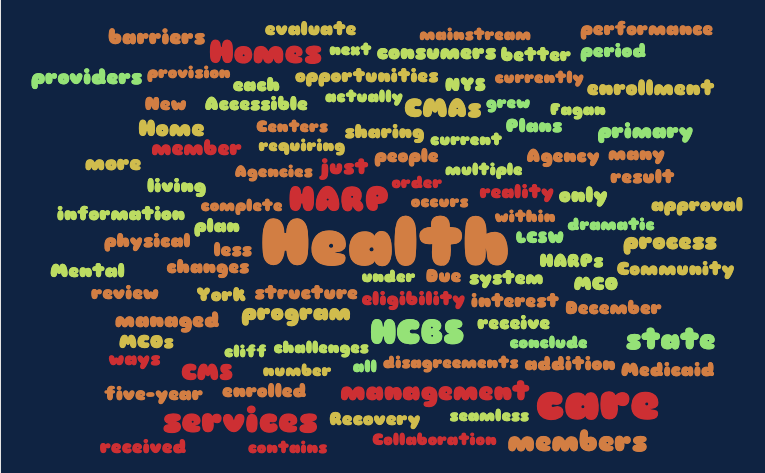Barriers and cliffs have surfaced in a five-year pilot program for managed care of Medicaid mental-health spending.

In 2015, New York State initiated a dramatic shift in how Medicaid funded behavioral health services would be managed. The state obtained approval from Centers for Medicare and Medicaid Services (CMS) to redesign and expand behavioral health services for people living with the most serious behavioral health and physical health challenges, under a specialized insurance product called Health and Recovery Plans (HARPs). The HARP program is of particular interest as its five-year demonstration period is scheduled to conclude on December 31, 2020.
The core changes involved the provision of care management services as the foundation of HARP, which evolved to be offered by care managers (CMs) employed by a managed care organization (MCO), a care management agency (CMA) in the Health Home program or Recovery Coordination Agency (RCA). In addition, Home and Community Based Services (HCBS) would be accessible to all eligible HARP and SNP members. The statewide behavioral health community showed vested interest in making these changes a reality; however, problems quickly emerged.
Hitting barriers
The NYS Department of Health’s (DOH) Health Homes program grew to certify approximately 30 Health Homes statewide, overseeing about 300 Care Management Agencies (CMAs). As originally envisioned, Health Homes would receive referrals from MCOs and then assign them to CMAs within their network. The CMAs would verify eligibility and then request member enrollment. In addition, Health Homes would review the CMAs progress notes and care plans, as well as train staff and evaluate performance.
In reality, the process hit many barriers. HARP members are significantly more expensive and less likely to be billable each month due to homelessness, incarceration, hospitalization and member disenrollment. Furthermore, Health Homes vary across the state in terms of size, structure and performance. Collaboration and information sharing is far from seamless and CMAs can belong to multiple Health Homes. Moreover, the financial structure does not incentivize connecting HARP enrollees to health home care management in comparison to mainstream managed care consumers.
Falling off a cliff
Since its inception in 2016, HCBS utilization remains extremely limited. According to data from the NYS Office of Mental Health (OMH), as of May 2020, 143,855 members are enrolled in the HARP program statewide. However, less than 25,000 people were assessed, and just over 5,000 actually received HCBS statewide.
The current HCBS enrollment process contains two cliffs where members fall off. The first is a steep dropoff from HARP to Health Home enrollment, where just 27 percent of HARP members are enrolled into Health Homes. The next downslide occurs when moving from HCBS assessment to services received, only 4 percent of HARP members receive HCBS.
 CityViews are readers’ opinions, not those of City Limits. Add your voice today!
CityViews are readers’ opinions, not those of City Limits. Add your voice today!
Due to federal requirements for conflict-free case management and setting restrictions for services, the HCBS eligibility process is cumbersome, requiring Health Homes (or RCAs) to assess the member, MCOs to approve their plan of care, a referral to providers to complete a treatment plan, which ultimately requires approval by the MCO. Understandably, many consumers and providers are frustrated with the length of time and number of steps. At each point, the system not only misses the opportunities for HCBS, but discourages consumers from continuing to participate in the care system entirely. Nearly five years later, the state is presently working with CMS to transition HCBS to Adult Rehabilitation Services (ARS) in order to streamline access. The process is currently in the public comment review phase.
A chance for improvement
The coming end to the five-year demonstration period presents opportunities to evaluate and develop ways to improve HARPs. We emphasize the importance of advancing integrated mental health, substance use and primary care, along with streamlining information sharing systems. Accessible, integrated care would fulfil a critical need for individuals living with chronic behavioral and physical health conditions, providing them with better care, and driving down preventable hospital and inpatient admissions.
New York State should explore more ways to assist providers committed to treating the whole person and addressing their multifaceted behavioral and primary care needs but face systemic and regulatory barriers to creating integrated pathways. Enabling the means to treat behavioral health and primary care services in one place would not only result in better outcomes, but also augment consumer satisfaction and care retention rates.
As a result of the factors discussed, I worry that on December 31, 2020, the state will not have achieved the deliverables set by CMS.
Michael Fagan, MPA, LCSW, is a health consultant. A more detailed and candid analysis can be downloaded from Google Drive by just clicking here, and the author invites you to share responses, corrections and edits to or disagreements with this discussion paper.









4 thoughts on “Opinion: Lessons Must be Learned from NYS Experiment in Mental Healthcare Funding”
Excellent article on the impact, or lack thereof, of both HARP and the Health Homes programs. We also need more information about the outcome of the DSRIP program. To what extent did DSRIP achieve its primary goal to reduce unnecessary admissions by 25%?
We need the HCBS in my community it does work very well. Less paperwork is needed for the Service Provider so they can spend more time in planning and executing action plans with Patients. We need to get credit as Peers who have marketing skills to promote the HARP. Did you know that in my county, MCO’s don’t promote the HARP Plan to consumers?
Great summary of program design and implementation. While the core of the design with its care management focus is vital, the assessment process is too cumbersome and ineffective in providing the supportive social determinants needed on a timely basis.
The folks needing the service the most challenged can be better supported with a safe, post-acute system of care that works to re-develop their lost social determinants and provide them with real opportunities to make their choices.
It’s a mistake to put State bureaucrats in control if smoothing out the malfunctions in a health care system beset by problems that are caused because State bureaucrats are in charge of those programs too.
It’s only ever going to end one way.
The State bureaucracy has to get out of the way.
They design systems that first and foremost are designed to satisfy their bureaucratic interests and viewpoint, and they don’t work for this.